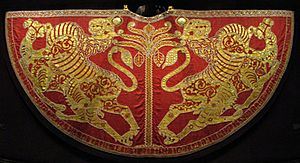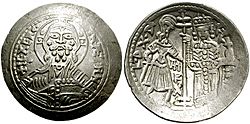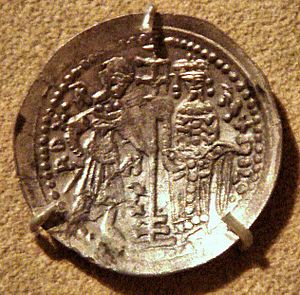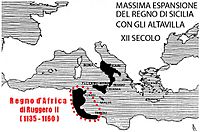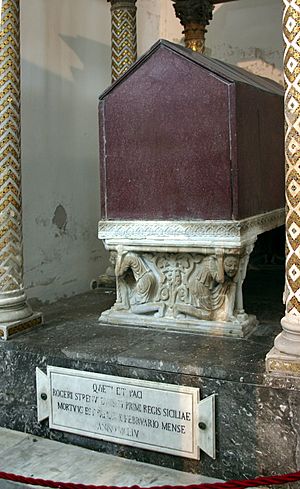Roger II of Sicily facts for kids
Quick facts for kids Roger II |
|
|---|---|
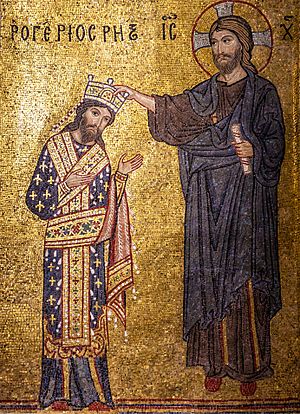
|
|
| Count of Sicily | |
| Reign | 1105 – 27 September 1130 |
| Predecessor | Simon |
| King of Sicily | |
| Reign | 27 September 1130 – 26 February 1154 |
| Coronation | 25 December 1130 |
| Successor | William I |
| Born | 22 December 1095 Mileto (Calabria) |
| Died | 26 February 1154 (aged 58) Palermo, Kingdom of Sicily |
| Burial | Cathedral of Palermo, Sicily |
| Spouse | Elvira of Castile Sibylla of Burgundy Beatrice of Rethel |
| Issue | Roger III, Duke of Apulia Tancred, Prince of Bari Alfonso of Capua William I of Sicily Constance I of Sicily Simon, Prince of Taranto |
| House | Hauteville |
| Father | Roger I of Sicily |
| Mother | Adelaide del Vasto |
| Religion | Roman Catholicism |
Roger II (Italian: Ruggero II; 22 December 1095 – 26 February 1154) was a powerful ruler who became the first King of Sicily. He was the son of Roger I of Sicily and took over from his brother Simon.
Roger started as the Count of Sicily in 1105. Later, he became the Duke of Apulia and Calabria in 1127. In 1130, he was crowned King of Sicily, and by 1148, he also ruled parts of North Africa, known as the Kingdom of Africa. By the time he died at 58, Roger had brought together all the lands conquered by the Normans in Italy. He created a strong kingdom with a powerful central government.
Contents
Early Life and Background
The Normans were adventurers from northern Europe who arrived in southern Italy around the year 999. By 1016, they were already involved in the local politics. They often worked as soldiers for hire, fighting for or against the Byzantine Empire. Over time, they slowly became the rulers of the main areas south of Rome.
Roger I, Roger II's father, was the Count of Sicily. Roger II was born in 1095 in Mileto, Calabria. His cousin, Roger Borsa, was the Duke of Apulia and Calabria. There were also many smaller rulers, called counts, who had power in their own areas. These counts were supposed to be loyal to one of the three main Norman rulers, but they often ignored this loyalty.
When Roger I died in 1101, his young son Simon became count. Simon's mother, Adelaide del Vasto, acted as his regent (someone who rules for a young king). Simon died four years later in 1105, when he was 12. Adelaide then became regent for her younger son, Roger, who was nine years old.
Roger's Reign
Becoming Ruler of Sicily
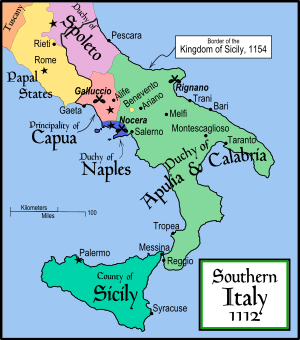
When his older brother Simon died in 1105, Roger became the Count of Sicily. His mother, Adelaide del Vasto, continued to rule for him. Important people like Christodulus, a Greek official from Palermo, helped her. In 1109, the Byzantine Emperor Alexios I Komnenos gave Roger an important title, protonobilissimos, because he knew a lot about the Byzantine court. In 1110, the Norwegian king Sigurd the Crusader visited Roger on his way to Jerusalem. Stories say Sigurd called Roger the King of Sicily, even though Roger wouldn't officially get that title for another 20 years.
In 1112, at 16, Roger began to rule on his own. A document from that time called him "now knight, now count of Sicily and Calabria." In 1117, his mother, who had married Baldwin I of Jerusalem, returned to Sicily. Her marriage was declared invalid. Roger seemed to feel insulted by this, which might explain why he wasn't keen on going on crusades later. Roger married his first wife, Elvira, who was the daughter of King Alfonso VI of Castile.
In 1122, Duke William II of Apulia was fighting with another count. William offered to give up his claims to Sicily and part of Calabria to Roger. In return, Roger gave William 600 knights and money for his fight.
Gaining Power in Southern Italy
When William II of Apulia died in 1127 without children, Roger claimed all the lands belonging to the Hauteville family on the Italian mainland. He also claimed control over the Principality of Capua. However, joining Sicily and Apulia was not popular. Both Pope Honorius II and the people of the duchy resisted this idea.
Becoming King
The popes had always been worried about the Normans becoming too powerful in southern Italy. In December 1127, the Pope called for a holy war against Roger. He encouraged Robert II of Capua and Ranulf II of Alife to fight Roger. But this group failed. In August 1128, Pope Honorius officially recognized Roger as the Duke of Apulia. The local lords, supported by cities like Naples, Bari, and Salerno who wanted more freedom, eventually gave in. By September 1129, Roger was widely accepted as the Duke of Apulia. He immediately started bringing order to the duchy, where the duke's power had been weak for a long time.
When Pope Honorius died in February 1130, two people claimed to be the new pope. Roger supported Antipope Anacletus II against Innocent II. As a reward, Anacletus made Roger the King of Sicily with a special paper called a papal bull on September 27, 1130. Roger was crowned in Palermo on Christmas Day 1130.
The Royal Mantle
Roger II's fancy royal mantle has the year 528 from the Islamic calendar (1133–34) written on it. This means it couldn't have been used for his coronation in 1130. This beautiful cloak was made for special events to show power. It was later used by Holy Roman Emperors for their coronations and is now in the Imperial Treasury in Vienna.
The mantle shows the mix of cultures in Roger's court in Palermo. It's made from red silk from the Byzantine Empire. It has gold embroidery, pearls, and jewels. The gold embroidery was likely done by Muslim artists, as it features Arabic writing. The mantle was made to show Roger II's high status and power. It also uses strong images, like two lions attacking camels, to show Roger's strength and victory.
Rebellions on the Mainland
Roger's support for Anacletus led to a ten-year war. Bernard of Clairvaux, who supported Innocent, gathered a group against Roger. This group included the kings of France and England, and the Holy Roman Emperor. Meanwhile, southern Italy rebelled against Roger.
In 1130, the Duchy of Amalfi rebelled. Roger sent his admiral, John of Palermo, to join forces and march on Amalfi by land. At the same time, George of Antioch blocked the town by sea. Amalfi soon gave up.
In 1132, Roger sent Robert II of Capua and Ranulf II of Alife to Rome to support Anacletus. While they were away, Roger's half-sister Matilda, Ranulf's wife, ran away to Roger. Roger also took over Ranulf's brother's land. Ranulf demanded his wife and land back, but Roger refused.
Roger first dealt with a rebellion in Apulia. He defeated Grimoald, Prince of Bari, and put his second son, Tancred, in charge. Meanwhile, Robert and Ranulf took the papal city of Benevento. Roger went to fight them but was defeated at the Battle of Nocera in July 1132. He went back to Salerno.
The next year, Emperor Lothair III came to Rome for his coronation. The rebel leaders met him, but Lothair's army was too small to help them. When the emperor left, Roger's enemies started fighting among themselves, which helped Roger. By July 1134, Roger's troops had forced Ranulf and others to surrender. Robert was kicked out of Capua, and Roger made his third son, Alfonso of Hauteville, the Prince of Capua. Roger II's oldest son, Roger, became the Duke of Apulia.
In 1135, a fleet from Pisa, led by the exiled prince of Capua, arrived in Naples. Ranulf, Robert, and Sergius joined them. They heard news that Roger was very sick or even dead. Many fortresses joined the rebels. Only Capua resisted. But on June 5, Roger arrived in Salerno, surprising everyone. His army easily took back lost areas. Most rebels hid in Naples, which Roger tried to capture. But he couldn't take it and returned to Messina later that year.
Imperial Invasion
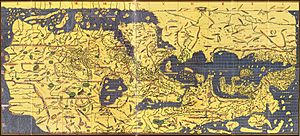
In 1136, a large army led by Emperor Lothair and Henry the Proud came to Italy to support the rebels. They besieged Salerno, the capital of Roger's kingdom on the mainland. Roger stayed in Sicily, leaving his garrisons (military posts) on the mainland without help. Even the Byzantine emperor sent money to Lothair. Salerno surrendered, and the large army marched south. In June 1137, Lothair captured Bari. In August, Lothair and the Pope made Ranulf the Duke of Apulia. Then the emperor went back to Germany.
Roger, now free from the biggest danger, immediately landed in Calabria with his troops. He was welcomed in Salerno and took back control of many areas. Sergius was forced to accept Roger as his ruler and switch his loyalty. This meant that the independent city of Naples became fully part of Roger's kingdom.
Roger then moved north. At the Battle of Rignano in October 1137, Roger and his son, along with Sergius of Naples, fought Duke Ranulf's army. It was Roger II's biggest defeat. Sergius died, and Roger fled to Salerno. Ranulf had now beaten Roger twice. Anacletus II died in January 1138, but Innocent II still refused to make peace with Roger.
In spring 1138, Roger's army invaded the Principality of Capua. Roger avoided a big battle and instead spread out Ranulf's army. Roger destroyed all the rebel castles and took a lot of treasure. In April 1139, Pope Innocent II officially removed Roger from the church. Ranulf, who had hidden in his capital, Troia, died of fever in April 1139. Roger had his body dug up and thrown in a ditch, but later regretted it and buried him properly.
With Sergius dead, Roger's son Alfonso was chosen to replace him. Alfonso and his brother Roger went to conquer the Abruzzi region.
Making the Kingdom Strong
After Anacletus died in January 1138, Roger wanted Pope Innocent to confirm his title as king. However, the Pope wanted Capua to be an independent state between Roger's kingdom and the Papal States, which Roger refused. In summer 1139, Innocent II invaded Roger's kingdom with a large army. But on July 22, 1139, Roger's son ambushed the Pope's army and captured Innocent. Three days later, in a treaty, the Pope declared Roger II "King of Sicily, Duke of Apulia and commander of Capua." The borders of his kingdom were set later in October 1144. These lands would form the kingdoms of Naples and Sicily for the next seven centuries.
In 1139, the city of Bari, with 50,000 people, surrendered. The leader of the rebellion, Jaquintus, was executed along with many of his followers. But the city itself was not destroyed. Roger's execution of Jaquintus was perhaps the most violent thing he did.
While his sons fought rebels on the mainland, Roger returned to Palermo in November 1139. He planned a major set of laws called the Assizes of Ariano. These laws aimed to make his lands in southern Italy into a single, strong state. He went to Ariano, a central town, to announce these laws. The laws gave the king and his government absolute power and reduced the power of the often rebellious local lords. While there, Roger also created a new standard coin, called the ducat.
Economy and Trade
Roger's changes to laws and government aimed to make his rule stronger and also to improve the economy of Sicily and southern Italy. He was very focused on making money but not very wasteful in spending it.
In 1140, at his meeting in Ariano, he introduced new coins, including smaller ones. This was to make trade easier with other parts of the Mediterranean Sea. However, while these new coins helped long-distance trade, they caused problems for local trade. By the 1150s, most of these coins were no longer used and soon disappeared.
Despite the issues with coinage, the Kingdom became very rich. Roger II gained a lot of wealth not only from his royal lands but also from his military campaigns. For example, he gained gold and silver from his campaigns in Apulia in 1133 and Greece in 1147.
Sicily's location in the middle of the Mediterranean Sea was perfect for trade with Europe, North Africa, and the Middle East. Its main export was durum wheat. Other exports included foods like cheese and fruits. Unlike other states, Sicily also had a strong government and military. This meant its merchants were supported and protected. This strong position led to more trade within the kingdom and a stronger market, which helped farming grow.
Later Years of Rule
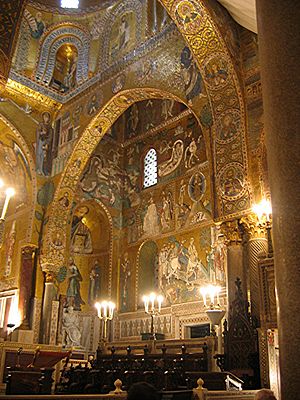
Roger had become one of the most important kings in Europe. In Palermo, he brought together smart people from different backgrounds. These included the famous Arab geographer Muhammad al-Idrisi and the Byzantine Greek historian Nilus Doxopatrius. Sicily, being in the center of the Mediterranean, had been ruled by many different groups. Roger welcomed learned people and allowed different religions, races, and languages to exist peacefully in his kingdom. To manage his lands, he hired many Greeks and Arabs. They were skilled in running a centralized government. He had people from many countries working for him. For example, the Englishman Thomas Brun was a royal official, and two Greeks, Christodulus and then George of Antioch, led his fleet. George was made ammiratus ammiratorum, which meant "Emir of Emirs" or chief minister. This title later became the English word admiral. Roger made Sicily the leading sea power in the Mediterranean.
A powerful navy was built under several admirals, the greatest being George. Thanks to him, Roger conquered parts of the African coast between 1146 and 1153. Tripoli was captured in 1146 and Cape Bona in 1148. However, these conquests were lost during the rule of Roger's son, William, and never became a permanent part of the kingdom in southern Italy.
The Second Crusade (1147–1148) gave Roger a chance to attack the Byzantine Empire again, which was a traditional enemy of the Normans. Roger himself never went on an expedition against Byzantium. Instead, he gave command to the skilled George. In 1147, George sailed from Otranto with 70 ships to attack Corfu. The island surrendered, partly because George offered bribes and because the imperial government had high taxes. The people welcomed the Normans as liberators. George left 1,000 men there and sailed to the Peloponnesus. He attacked Athens and quickly moved to the Aegean Islands. He raided the coast along Euboea and the Gulf of Corinth. He went as far as Thebes, where he took silk factories and Jewish weavers. He brought them back to Palermo, where they helped start the Sicilian silk industry. George finished the expedition by attacking Corinth and stealing holy items. He then returned to Sicily. In 1149, Corfu was taken back by the Byzantines. George then led a mission against Constantinople, but he couldn't land. Instead, he shot arrows at the palace windows to challenge the Byzantine emperor. Despite this, his mission didn't have lasting effects.
Roger died in Palermo on February 26, 1154, and was buried in the Cathedral of Palermo. His fourth son, William, became king after him.
Modern Impact
Roger is the main character in King Roger, an opera from 1926 by Polish composer Karol Szymanowski. The last months of his life are also featured in Tariq Ali's book A Sultan in Palermo. A private university, Studiorum Universitas Ruggero II, was named in his honor in 2001.
Family Life
Roger's first marriage was in 1117 to Elvira, daughter of King Alfonso VI of Castile. When she died, people thought Roger had died too, because his sadness made him withdraw from public life. They had six children:
- Roger (1118 – 1148), who was the heir and Duke of Apulia.
- Tancred (1119–1138), Prince of Bari.
- Alfonso (around 1120 – 1144), Prince of Capua and Duke of Naples.
- A daughter (died young in 1135).
- William (1120/1121 – 1166), who became king after Roger.
- Henry (1135 – died young).
Roger's second marriage was in 1149 to Sibylla, daughter of Hugh II, Duke of Burgundy. They had two children:
- Henry (1149 – died young).
- A child born stillborn (1150).
Roger's third marriage was in 1151 to Beatrice of Rethel, a grandniece of King Baldwin II of Jerusalem. They had one daughter:
- Constance (born after Roger's death, 1154 – 1198), who married Emperor Henry VI and later became Queen of Sicily.
Roger also had five known children born outside of marriage:
- Simon, who became Prince of Taranto in 1144.
- A daughter, who married Rodrigo Garcés.
- A daughter, who married Adam, a nobleman from Naples.
- Clemenza, who married Hugues II, Count of Molise.
- Adelisa (died after 1184/87), who married twice.
- Marina, who married the admiral Margaritus of Brindisi.
See also
 In Spanish: Roger II de Sicilia para niños
In Spanish: Roger II de Sicilia para niños
- Palazzo dei Normanni (palace)


